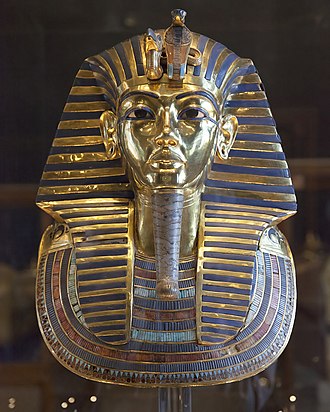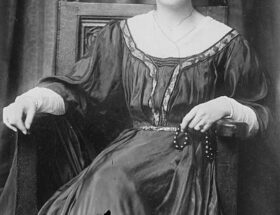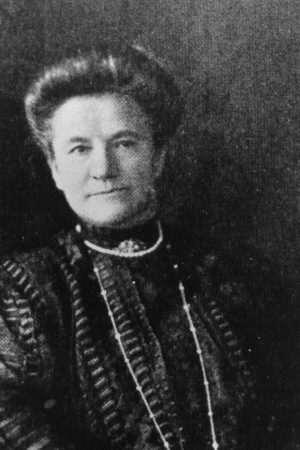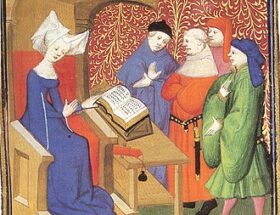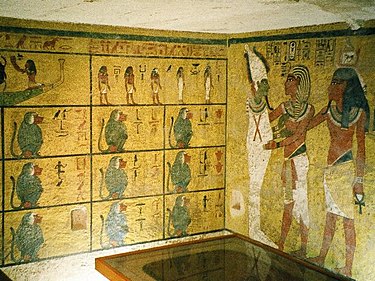
Discovery
Lord Carnarvon employed British Egyptologist Howard Carter to excavate the site of KV62 and Carter returned to a line of huts that he had abandoned a few seasons earlier. The crew cleared the huts and rock debris beneath while their young water boy stumbled on a stone which turned out to be the top of a flight of steps cut into the bedrock.
Carter had the steps partially dug out until the team found the top of a mud-plastered doorway. The doorway was stamped with indistinct cartouches (oval seals with hieroglyphic writing). Carter ordered the staircase to be refilled and sent a telegram to Carnarvon, who arrived on 23 November 1922 along with his 21-year-old daughter Lady Evelyn Herbert.
The excavators cleared the stairway completely, which revealed clearer seals lower down on the door bearing the name of Tutankhamun. However, further examination showed that the door blocking had been breached and resealed on at least two occasions.
Clearing the blocking led to a downward corridor that was completely blocked with packed limestone chippings, through which a robbers’ tunnel had been excavated and anciently refilled. At the end of the tunnel was a second sealed door that had been breached and resealed in antiquity.
Carter then made a hole in the door and used a candle to check for foul gases before looking inside.
“At first I could see nothing,” he wrote, “the hot air escaping from the chamber causing the candle flame to flicker, but presently, as my eyes grew accustomed to the light, details of the room within emerged slowly from the mist, strange animals, statues, and gold – everywhere the glint of gold.” After a pause, Carnarvon asked, “Can you see anything?” Carter replied, “Yes, wonderful things.”
Carter’s team opened the tomb on November 29 and made the first announcement and press conference the next day. The first item was removed from the tomb on December 27.
On February 16, 1923, the team opened the burial chamber. The granite lid of the sarcophagus was raised on February 12, 1924. In April, Carter argued with the Antiquities Service and left the excavation for the United States.
In January 1925, Carter resumed activities in the tomb and removed the cover of the first sarcophagus on October 13, the cover of the second sarcophagus on October 23 and finally the cover of the final sarcophagus on October 28, exposing the mummy.
The examination of the remains of Tutankhamun began on November 11. Works in the treasury began on October 24, 1926 and between October 30 and December 15, 1927 the annex was emptied and examined. The last objects from the tomb were removed on November 10, 1930, eight years after the discovery.
Layout of the tomb
The tomb’s design suggests that it was originally intended for a private individual not for royalty. This is supported by the fact that only the burial chamber walls were decorated, unlike royal tombs in which nearly all walls were painted with scenes from the netherworld books.
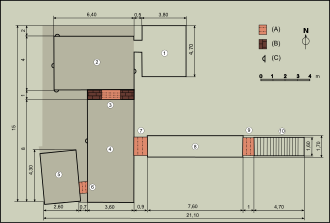
Sixteen steps descend from a small, level platform to the first doorway which was sealed and plastered (although evidence suggests it was penetrated twice by grave robbers).
Beyond the first doorway, a descending corridor leads to the second sealed door and into a room described as the antechamber by Carter. This was used originally to hold material left over from the funeral and material associated with embalming the king.
After an initial robbery, this material was moved either into the tomb proper or to KV54 and the corridor was sealed with packed limestone chippings which covered some debris from the first robbery. A later robbery broke through the outer door and excavated a tunnel through the chippings to the second door. The robbery was discovered and the second door was resealed, the tunnel refilled, and the outer door sealed again.
Some remnants in the corridor appear to have been from a funerary meal matching one discovered by Davis in jars in KV54. Carter said that he found the Head of Nefertem in this section.
The undecorated antechamber was found in a state of “organized chaos”, partly due to ransacking during the robberies. It contained approximately 700 objects (articles 14 to 171 in the Carter catalogue) among which were three funeral beds, one in the form a lion (the goddess Mehet), one in the shape of a spotted cow (representing Mehet-Weret) and one in the form of a composite animal with the body of a lion, the tail of a hippopotamus, and the head of a crocodile (representing the corpse-devourer Ammit).
Perhaps the most remarkable item in this room were the stacked components of four chariots, one for hunting, one for war and the other two for parades. A large chest was found to contain military items, walking sticks, the king’s underwear and a copper alloy trumpet (one of two found in the tomb and the oldest functioning brass instruments in the world)
Burial chamber
This is the only decorated chamber in the tomb, with scenes from the opening of the mouth ceremony (showing Ay, Tutankhamun’s successor acting as the king’s son) and Tutankhamun with the goddess Nut on the north wall, the twelve hours of Amduat (on the west wall), spell one of the Book of the Dead (on the east wall) and representations of the king with various deities (Anubis, Isis, Hathor and others now destroyed) on the south wall. The north wall shows Tutankhamen being followed by his Ka, being welcomed to the underworld by Osiris.
Some of the treasures in Tutankhamun’s tomb are noted for their apparent departure from traditional depictions of the boy king. Certain cartouches where a king’s name should appear have been altered, as if to reuse the property of a previous pharaoh.
However, this instance may simply be the product of “updating” the artifacts to reflect the shift from Tutankhaten to Tutankhamun. Other differences are less easy to explain, such as the older, more angular facial features of the middle coffin and canopic coffinettes.
The most widely accepted theory for these latter variations is that the items were originally intended for Smenkhkare, who might be the mysterious KV55 mummy. This mummy according to craniological examinations bears a striking first-order (father-to-son or brother-to-brother) relationship to Tutankhamun.
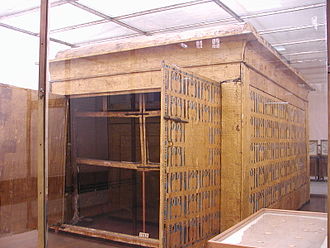
The entire chamber was occupied by four gilded wooden shrines which surrounded the king’s sarcophagus. The outer shrine measured 5.08 x 3.28 x 2.75 m and 32 mm thick, almost entirely filling the room, with only 60 cm at either end and less than 30 cm on the sides. Outside of the shrines were 11 paddles for the “solar boat”, containers for scents, and lamps decorated with images of the god Hapi.
On the second shrine inscriptions of the Enigmatic Book of the Netherworld (a two-part ancient Egyptian funerary text written in cryptographic code) can be found. The text is broken into three sections that incorporate other funerary texts, such as the Book of the Dead and the Amduat.
The text is notable for containing the first known depiction of the ouroboros symbol, in the form of two serpents (interpreted as manifestations of the deity Mehen) encircling the head and feet of a god, taken to represent the unified Ra-Osiris.
The fourth and innermost shrine was 2.90 m long and 1.48 m wide. The wall decorations depict the king’s funeral procession and Nut was painted on the ceiling, “embracing” the sarcophagus with her wings.

This sarcophagus was constructed in quartzite with a lid of rose granite tinted to match. It appears to have been constructed for another owner (whose identity was not preserved), but then recarved for Tutankhamun. In each corner a protective goddess (Isis, Nephthys, Serket and Neith) guards the body.
Inside, the king’s body was placed within three mummiform coffins, the outer two made of gilded wood while the innermost was composed of 110.4 kilograms (243 lb) of pure gold. Tutankhamun’s mummy was adorned with a gold mask, mummy bands and other funerary items.
The funerary mask is made of gold, inlaid with lapis lazuli, carnelian, quartz, obsidian, turquoise, glass and faience, and weighs 11 kilograms (24 lb).
Treasury
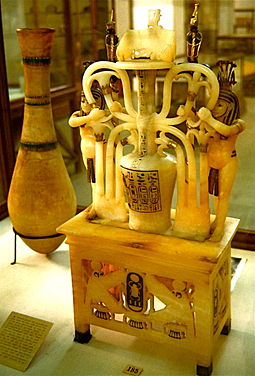
An alabaster jar found in the tomb 
Tutankhamun’s wooden chest
The treasury was the burial chamber’s only side-room and was accessible by an unblocked doorway. It contained over 5,000 catalogued objects, most of them funerary and ritual in nature. The two largest objects found in this room were the king’s elaborate canopic chest and a large statue of Anubis.
Other items included numerous shrines containing gilded statuettes of the king and deities, model boats and two more chariots. This room also held two mummies of fetuses that DNA has shown to have been stillborn offspring of the king.
Annex
The annex, originally used to store oils, ointments, scents, foods and wine, was the last room to be cleared, from the end of October 1927 to the spring of 1928. Although small in size, it contained approximately 280 groups of objects, totaling more than 2,000 individual pieces. Also found within the annex chamber were 26 jars containing wine residue.
Possible undiscovered chambers
In 2015 research by Egyptologist Nicholas Reeves from the University of Arizona suggested that there may be areas of the tomb worthy of further analysis. Reeves investigated high-resolution digital scans of the tomb taken by Madrid-based company Factum Arte that were used in the process of creating a facsimile of the tomb.
Reeves noted markings in the plaster of the burial chamber that appeared to suggest the possibility of a small door in the west wall of the burial chamber, of the same dimensions as the annex door.
According to Reeves, markings on the north wall could also suggest that the wall itself may partly be a blocking wall covering a void, possibly indicating that the “antechamber” continues as a corridor beyond the north wall.
Although the “doors” may just be uncompleted construction work, one possibility that has been suggested is that Tutankhamun is actually buried in the outer section of a larger tomb complex (similar to the tomb of Amenhotep III) that has been sealed off by the north wall, and that a further burial (possibly that of Nefertiti) may exist elsewhere in undiscovered areas of the tomb.
In November 2015, a ground-penetrating radar scan was conducted by Hirokatsu Watanabe, a Japanese radar expert. His results appeared to confirm Reeves’ hypothesis, indicating that there were voids behind the west and north walls of the burial chamber.
A second GPR scan could not replicate Watanabe’s findings. A third scan was carried out by researchers from the Polytechnic University of Turin, the University of Turin and two private companies, which found no evidence of any hidden chambers, thereby disproving Reeves’ hypothesis.
They concluded that the initial positive result was likely caused by reflections of the walls themselves, or even interference from the sarcophagus. The Egyptian Ministry of State of Antiquities reviewed and accepted these results, which were presented in May 2018.
In 2019 Nicholas Reeves reviewed and extended his original hypothesis, including a review of the available geophysical data by geophysicist and radar expert George Ballard. This includes not only the three radar scans, but correlates these with the ERT results published earlier by the same research team from the Polytechnic University of Turin and the University of Turin.
Ballard agreed that that no open chambers or spaces had been located immediately behind the walls, but observed that the radar data from the zone behind the North and Treasury walls was more consistent with a rubble fill, indicative of a possible anthropic origin, rather than natural rock.
The location in the ERT data of two isolated resistivity anomalies consistent with voided spaces, close to the same level as KV62, but separated from it, raises the possibility that there is a back filled passageway behind the walls leading to further chambers. This analysis is supportive of Reeves’ original hypothesis, and contradicts the conclusion, accepted previously by the Ministry of Antiquities.
